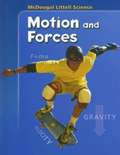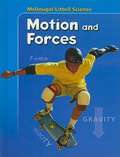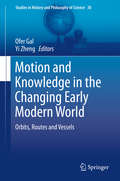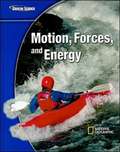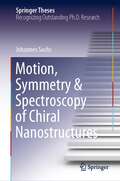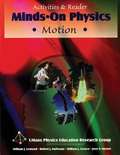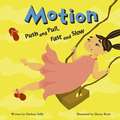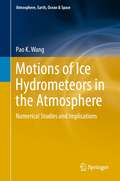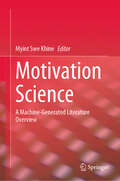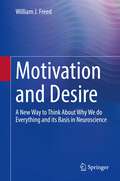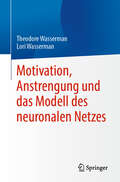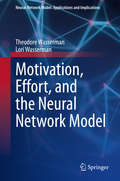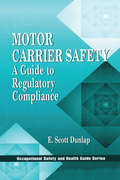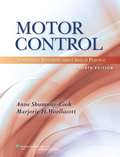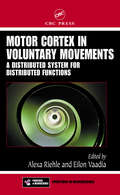- Table View
- List View
Motion Deblurring
by Rama Chellappa A. N. RajagopalanA comprehensive guide to restoring images degraded by motion blur, bridging the traditional approaches and emerging computational photography-based techniques, and bringing together a wide range of methods emerging from basic theory as well as cutting-edge research. It encompasses both algorithms and architectures, providing detailed coverage of practical techniques by leading researchers. From an algorithms perspective, blind and non-blind approaches are discussed, including the use of single or multiple images; projective motion blur model; image priors and parametric models; high dynamic range imaging in the irradiance domain; and image recognition in blur. Performance limits for motion deblurring cameras are also presented. From a systems perspective, hybrid frameworks combining low-resolution-high-speed and high-resolution-low-speed cameras are described, along with the use of inertial sensors and coded exposure cameras. Also covered is an architecture exploiting compressive sensing for video recovery. A valuable resource for researchers and practitioners in computer vision, image processing, and related fields.
Motion Mountain: Light, Charges and Brains, Twenty-third edition)
by Christoph SchillerAnswering questions on motion, the book gives an entertaining and mind-twisting introduction into modern physics--one that is surprising and challenging on every page. Starting from everyday life, the adventure provides an overview of the recent results in mechanics, thermodynamics, electrodynamics, relativity, quantum theory, quantum gravity and unification. It is written for undergraduate students and for anybody interested in physics.
Motion and Design
by Editors at the National Science Resources CenterThis book talks about how living organisms' structures influence the way they function in nature and how scientists and inventors developed devices that helped people move more effectively.
Motion and Forces
by Mcdougal-Littell Publishing StaffLearn more about gravity, velocity and other scientific principles of motion and action.
Motion and Knowledge in the Changing Early Modern World
by Yi Zheng Ofer GalThis volume comprises studies of the early modern drama of motion and transformation of knowledge. It is unique in taking its global nature as fundamental and contains studies of the theme of motion and knowledge in China, Europe and the Pacific from the 16th to the 18th century. People living around the turn of the 17th century were experiencing motion in ways beyond the grasp of anyone less than a century earlier. Goods and people were crossing lands and oceans to distances never envisioned and in scales hardly imaginable by their recent predecessors. The earth itself has been set in motion and the heavens were populated by a whole new array of moving objects: comets, moons, sun spots. Even the motion of terrestrial objects--so close at hand and seemingly obvious--was being thoroughly reshaped. In the two centuries to follow, this incessant, world-changing motion would transform the creation, interpretation and dissemination of knowledge and the life and experiences of the people producing it: savants, artisans, pilots, collectors.
Motion and Matter
by Lawrence Hall of Science University of California at BerkeleyNIMAC-sourced textbook
Motion, Force, and Models
by Lawrence Hall of Science University of California at BerkeleyNIMAC-sourced textbook
Motion, Forces, and Energy
by Glencoe Mcgraw-HillDiscover the Flexibility to Teach Science Your Way!. "Glencoe Science: Motion, Forces, and Energy," a module in the Glencoe Science 15 book series, provides students with accurate and comprehensive coverage of middle school National Science Education Standards. Concepts are explained in a clear, concise manner, and are integrated with a wide range of hands-on experiences, critical thinking opportunities, real-world applications, and connections to other sciences and to non-science areas of the curriculum. Co-authored by National Geographic, unparalleled graphics reinforce key concepts. A broad array of print and technology resources help differentiate and accommodate all learners. The modular approach allows you to mix and match books to meet your specific curriculum needs.
Motion, Symmetry & Spectroscopy of Chiral Nanostructures (Springer Theses)
by Johannes SachsThis book focuses on complex shaped micro- and nanostructures for future biomedical and sensing applications that were investigated by both theory and experiments.The first part of the book explores rotation-translation coupling of artificial microswimmers at low Reynolds numbers. Usually corkscrew shapes, i.e chiral shapes, are considered in such experiments, due to their inspiration from nature. However, the analysis of the relevant symmetries shows that achiral objects can also be propulsive, which is experimentally demonstrated for the first time.In the second part, a new single-particle spectroscopy technique was developed and the role of symmetry in such measurements is carefully examined. Spectra stemming from one individual nanoparticle that is moving freely in bulk solution, away from a surface, and only due to Brownian motion, are presented. On that basis, the rotationally averaged chiroptical spectrum of a single nanoparticle is measured - a novel observable that has not been accessible before.
Motion: Activities and Reader (Minds on Physics)
by William J. Leonard Robert J. Dufresne William J. Gerace Jose P. MestreLearn more about the physics of motion in this activity book that will stretch your mind.
Motion: Push and Pull, Fast and Slow
by Darlene R. Stille Sheree BoydThe book discusses concept of motion and related topics like movement, speed, force, and inertia with fun facts and experiments.
Motions of Ice Hydrometeors in the Atmosphere: Numerical Studies and Implications (Atmosphere, Earth, Ocean & Space)
by Pao K. WangThis book summarizes unique research findings on the hydrodynamic behavior of ice particles (ice crystals, snow, graupel and hailstones) in the atmosphere. The fall behavior of ice hydrometeors determines how and how fast a mixed-phase cloud can grow or dissipate. The book discusses how the authors used computational fluid dynamics (CFD) methods and numerical simulations to determine these behaviors, and presents these computations along with numerous detailed tables and illustrations of turbulent flow fields. It also examines the implications of the results for the general atmospheric sciences as well as for climate science (since the cloud problem is the source of the greatest uncertainty in model-based climate predictions). As such it allows readers to gain a clear and comprehensive understanding of how particles fall in clouds and offers insights into cloud physics and dynamics and their impact on the climate..
Motivation Science, Level 5, Student Edition
by Mentoring MindsTexas Science textbook for 5th Grade
Motivation Science: A Machine-Generated Literature Overview
by Myint Swe KhineThis volume explores human-machine collaboration and provides machine-generated auto-summaries of emerging research trends in motivation science. Each chapter presents summaries of pre-defined themes and includes an editor-written introduction. It covers various topics, from classic theories such as Maslow's hierarchy of needs to cutting-edge research in neuroscience and cultural influences on motivation. The book offers valuable insights into what makes us tick and how to harness motivation to improve our lives. The book is organized into six chapters covering interrelated topics such as the motivation science, emotion-based motivation, educational motivation, self-regulated learning, motivation and technology, and motivation and neuroscience. The auto-summaries have been generated by a recursive clustering algorithm via the Dimensions Auto-summarizer by Digital Science. The editor of this book selected which SN content should be auto-summarized and decided its order of appearance. Please note that these are extractive auto-summaries, consisting of original sentences, but are not representative of the original paper, since we do not show the full length of the publication. Please note that only published SN content is represented here, and that machine-generated books are still at an experimental stage.
Motivation and Desire: A New Way to Think About Why We do Everything and its Basis in Neuroscience
by William J. FreedSome of our time is spent eating and drinking and some is spent on matters regarding reproduction. Some of us seek fame or recognition while others seek satisfaction internally, with little need for recognition. Some people study for success in a profession, while others might study rocks, birds, or French literature for no apparent reason other than to know about it. Why are we motivated to engage in so many apparently unrelated activities? This book places our various activities into categories, thus providing a framework for understanding how everything that we do fits together and is based on brain mechanisms. Disturbances in motivation play important roles in autism, depression, Parkinson's disease, and addiction. Understanding the motivational aspects of these disorders can help to inform our approach to these conditions. This book may be of value for students in psychology, counseling, management, and anyone who is interested in understanding our daily behavior.
Motivation in Humor (Controversy Ser.)
by Jacob LevineThis is not a funny book--but it is the first to bring together contemporary experimental studies on humor. The fourteen scholarly papers included here mark an important breakthrough in this vital, complex, and largely unexplored subject. Motivation in Humor shows that humor is researchable by scientific methods and indicates the difficulties involved in such work. Here are samples of the important parameters of behavior and attempts at defining the factors that influence the humor response as well as the effects of this response upon subsequent emotional states. In his expert introductory chapter, Jacob Levine traces the progress of humor research and analyzes the papers that follow. To summarize a few of his findings: Three basic research models--three conflicting models of the motivation of man--have been used to explain the motivational sources of humor: one is positive, one negative, and one mixed. These are: (1) cognitive-perceptual theory, which stresses the successful and surprising resolution of an incongruity, paradox, or double entendre; (2) behavior theory, with its emphasis on stimulus-response learning and the reduction of base drives; and (3) psychoanalytic theory, which emphasizes the gratification of the primary unconscious drives of sex and aggression in conjunction with the pleasures of mental activity that sometimes involve regression to infantile modes of thinking. The development of humor reflects an interaction between innate psycho physiological processes and learned response patterns. Evidence indicates that humor is influenced by such diverse situations and individual dispositions as interpersonal anxiety, prior emotional set, and social setting. Studies also point to the cathartic effects of humor appreciation, particularly with aggressive or tendentious humor. The considerable research prompted by these ideas has begun to throw some light on the positive motives, a reflection of the new approaches to motivation theory. Teachers will fi
Motivation, Anstrengung und das Modell des neuronalen Netzes
by Theodore Wasserman Lori WassermanIn den letzten zehn Jahren hat sich unser Verständnis des menschlichen Gehirns grundlegend gewandelt – von einer modularen Struktur hin zu einem hoch integrierten neuronalen Netzwerkmodell. Dieses neue Verständnis verändert grundlegend die Art und Weise, wie wir wesentliche psychologische Konstrukte wie beispielsweise Motivation erklären. Im Netzwerkmodell wird Motivation als ein spezialisierter Aspekt des menschlichen Lernsystems betrachtet, der darauf abzielt, Ziele zu erreichen. Von ursprünglich grundlegenden Bedürfnissen wie Nahrung und Unterkunft entwickelt sich Motivation im Laufe der Zeit zu einem komplexen Geflecht aus extrinsischen und intrinsischen Zielen. Der Kern all dieser Entwicklungen ist die angeborene Flucht- oder Kampfreaktion, die sich im Laufe der Zeit durch eine Kombination aus angeborenen menschlichen Temperamentseigenschaften und Lebenserfahrungen verändert. Diese Veränderungsprozess basiert zum Teil auf einem Fehlerprognosenetzwerks, das mit dem Belohnungsnetzwerk zusammenarbeitet, um ein System sich ständig weiterentwickelnder Bewertungen von Zielen und Vorgaben zu erzeugen. Das Zusammenspiel dieser Netzwerke führt zu einem kognitiven Prozess, den wir Motivation nennen. Wie die meisten Netzwerke wird das Motivationssystem von Netzwerken rekrutiert, wenn die Aufgabenanforderungen der Situation es erfordern. Solch ein Verständnis von Motivation hat tiefgreifende Auswirkungen. In der klinischen Psychologie könnte es die Beurteilung und Therapie von Verhaltensweisen neugestalten und die Richtung für neue therapeutische Interventionen vorgeben. Dieses Buch stellt die Übersetzung einer englischsprachigen Originalausgabe dar. Die Übersetzung wurde mit Hilfe von künstlicher Intelligenz erstellt. Eine anschließende manuelle Überarbeitung erfolgte vor allem nach inhaltlichen Gesichtspunkten, so dass das Buch stilistisch von einer herkömmlichen Übersetzung abweicht.
Motivation, Effort, and the Neural Network Model (Neural Network Model: Applications and Implications)
by Theodore Wasserman Lori WassermanOur understanding of how the human brain operates and completes its essential tasks continues is fundamentally altered from what it was ten years ago. We have moved from an understanding based on the modularity of key structural components and their specialized functions to an almost diametrically opposed, highly integrated neural network model, based on a vertically organized brain dependent on small world hub principles. This new understanding completely changes how we understand essential psychological constructs such as motivation. Network modeling posits that motivation is a construct that describes a modified aspect of the operation of the human learning system that is specifically designed to cause a person to pursue a goal. Anthropologically and developmentally, these goals were initially basic, including things like food, shelter and reproduction. Over the course of time and development they develop into a complex web of extrinsic and then intrinsic goals, objectives and values. The core for all of this development is the inborn flight or fight reaction has been modified over time by a combination of inborn human temperamental characteristics and life experiences. This process of modification is, in part, based on the operation of a network based error-prediction network working in concert with the reward network to produce a system of ever evolving valuations of goals and objectives. These valuations are never truly fixed. They are constantly evolving, being modified and shaped by experience. The error prediction network and learning related networks work in concert with the limbic system to allow affect laden experiences to inform the process of valuation. These networks, operating in concert, produce a cognitive process we call motivation. Like most networks, the motivation system of networks is recruited when the task demands of the situation require them. Understanding motivation from this perspective has profound implications for many scientific disciplines in general and psychology in specific. Psychologically, this new understanding will alter how we understand client behavior in therapy and when being evaluated. This new understanding will provide direction for new therapeutic intervention for a variety of disorders of mental health. It will also inform testing practices concerning the evaluation of effort and malingering. This book is not a project in reductionism. It is the polar opposite. A neural network understanding of the operation of the human brain allows for the integration of what has come before into a comprehensive and integrated model. It will likely provide the basis for future research for years to come.
Motor Carrier Safety: A Guide to Regulatory Compliance
by Erik Scott DunlapThe need to understand and follow applicable government regulations is critical to providing safety for everyone affected by the transportation industry. Motor Carrier Safety simplifies the many complexities of legal compliance for the transportation of goods by highway. It provides you with the tools and focus required to achieve full regulatory compliance.The author examines current regulations to determine what issues and requirements pertain to such issues as hazardous materials, drugs and alcohol, employee safety and health. Bulleted lists present the regulations in a clear, easy-to-use format. You will understand the issues and be able to determine the specific regulations that affect your place of business. In addition to regulations and standards, this book covers points of training, record keeping, and suggestions for annual audits. Case studies relating to various regulations help you realize how either violating or complying will impact your business. These features combine to make Motor Carrier Safety the perfect vehicle for launching your in-house training program. The laws governing the transportation of goods by truck vary from agency to agency. Motor Carrier Safety makes clear the regulations and provides the you with a practical source for complying with them. This book helps you to understand your regulatory exposure for non-compliance and guides you through the steps to becoming compliant.
Motor Control: Translating Research into Clinical Practice (4th Edition)
by Anne Shumway Cook Marjorie H. WoollacottThis book tries to reduce the gap between research and clinical practice that is created as a result of explosion of new research in the field of neuroscience and motor control.
Motor Cortex in Voluntary Movements: A Distributed System for Distributed Functions
by Alexa Riehle Eilon VaadiaAs one of the first cortical areas to be explored experimentally, the motor cortex continues to be the focus of intense research. Motor Cortex in Voluntary Movements: A Distributed System for Distributed Functions presents developments in motor cortex research, making it possible to understand and interpret neural activity and use it to recons


